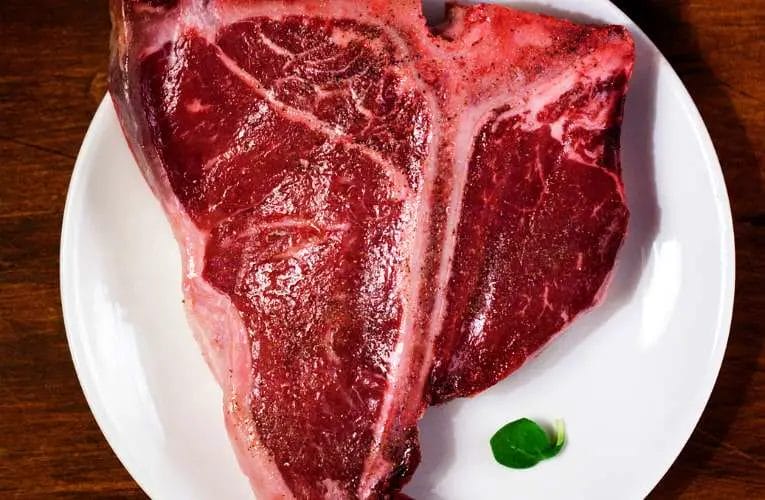T-bone steak, a popular cut of beef, is known for its rich flavor and tenderness. While it is delicious, it is important to consider its nutritional value. T-bone steak is a good source of high-quality protein, iron, zinc, and B vitamins.
However, it is also high in saturated fat, so it should be enjoyed in moderation as part of a balanced diet. Incorporating leaner cuts of meat and focusing on portion control can help maintain a healthy lifestyle while still savoring the occasional T-bone steak.

Nutritional Profile of T-Bone Steak
When it comes to indulging in a delectable and juicy steak, the T-bone cut is often a top choice for many meat lovers. But aside from its mouthwatering taste, it’s essential to understand the nutritional profile of T-bone steak.
This knowledge can help us make informed decisions about our dietary choices and ensure we maintain a balanced and healthy lifestyle.
Here is a breakdown of the key nutrients found in a typical T-bone steak:
Protein
Protein is a vital nutrient that plays a crucial role in building and repairing tissues in our body. T-bone steak is an excellent source of high-quality protein, providing around 23 grams per 100 grams of serving.
Including T-bone steak in your diet can help meet your daily protein requirements and support muscle development and growth.
Fat
T-bone steak contains a moderate amount of fat, including both saturated and unsaturated fats. The quantity of fat can vary depending on the cut and marbling of the steak.
It is important to note that while moderate fat intake is necessary for a healthy diet, excessive consumption may lead to weight gain and other health issues. It is recommended to enjoy T-bone steak in moderation and balance it with other nutrient-rich foods.
Iron
T-bone steak is a rich source of iron, a mineral essential for the production of red blood cells. Consuming iron-rich foods like T-bone steak can help prevent iron deficiency anemia and promote healthy blood circulation.
A 100-gram serving of T-bone steak provides approximately 2.9 milligrams of iron, which is about 16% of the recommended daily intake for adults.
Vitamin B12
Vitamin B12 is a crucial nutrient that plays a vital role in maintaining healthy nerve cells and red blood cells. It is primarily found in animal-based foods, making T-bone steak an excellent source of this essential vitamin.
A 100-gram serving of T-bone steak can provide around 1.4 micrograms of vitamin B12, which is more than the recommended daily intake for most individuals.
Zinc
T-bone steak is also a good source of zinc, a mineral that supports various bodily functions, including immune system function, wound healing, and protein synthesis. Zinc deficiency can lead to weakened immunity and impaired growth.
Incorporating T-bone steak into your diet can help ensure an adequate intake of zinc. A 100-gram serving of T-bone steak provides approximately 4 milligrams of zinc, which is about 36% of the recommended daily intake for adults.
Other Micronutrients
T-bone steak also contains other essential micronutrients, including vitamin B6, niacin, phosphorus, and selenium. These nutrients contribute to overall health and well-being, supporting various bodily processes such as energy production, brain function, and antioxidant defense.
While T-bone steak offers several nutritional benefits, it’s important to consume it in moderation as part of a well-balanced diet. Pairing it with a variety of vegetables, whole grains, and other lean protein sources will help ensure a diverse and nutritionally sound meal.
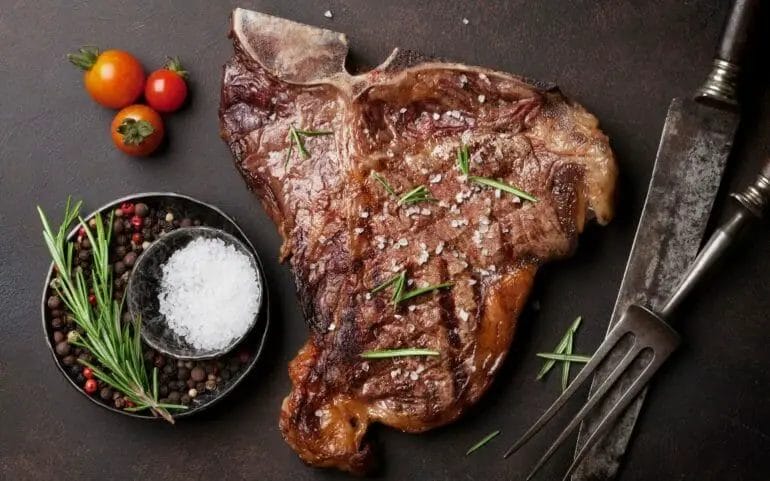
Tips for cooking the perfect T-bone steak
If you’re a steak lover, there’s nothing quite like a perfectly cooked T-bone steak. This cut of beef is known for its tenderloin and striploin sections, offering a combination of melt-in-your-mouth tenderness and rich, beefy flavor.
However, cooking a T-bone steak to perfection can be a challenge. To help you achieve the best results, here are some tips to keep in mind:
1. Choose a good quality steak
The first step to cooking a delicious T-bone steak is selecting a high-quality piece of meat. Look for steaks that have good marbling, which refers to the white streaks of fat running through the meat.
Marbling adds flavor and juiciness to the steak, enhancing the overall eating experience. Opt for USDA Prime or Choice grades for the best quality.
2. Bring the steak to room temperature
Before cooking the T-bone steak, it’s important to let it come to room temperature. This allows for more even cooking throughout the steak. Simply take the steak out of the refrigerator and let it sit on the counter for about 30 minutes to 1 hour before cooking.
3. Season generously
To enhance the natural flavors of the T-bone steak, season it generously with salt and pepper. Make sure to coat both sides of the steak and gently press the seasoning into the meat. For extra flavor, you can also add your favorite steak rub or seasoning blend.
4. Preheat your grill or skillet
Whether you prefer grilling or pan-searing, it’s crucial to preheat your cooking surface. For grilling, heat the grill to high heat, around 450°F to 500°F. For pan-searing, preheat a cast-iron skillet over medium-high heat until it’s hot and evenly heated.
5. Sear the steak
To achieve a delicious crust on the outside of the T-bone steak, start by searing it on high heat. Place the steak on the grill or in the hot skillet and let it cook undisturbed for about 3 to 4 minutes per side. This will create a beautiful caramelization and add depth of flavor to the steak.
6. Use the indirect heat method
After searing the steak, it’s important to finish cooking it using the indirect heat method. For grilling, move the steak to a cooler part of the grill or reduce the heat to medium-low.
For pan-searing, lower the heat to medium. Cook the steak for an additional 4 to 6 minutes per side, depending on the desired level of doneness.
7. Test for doneness
To ensure that your T-bone steak is cooked to your desired level of doneness, use a meat thermometer to check the internal temperature. Here are the approximate temperatures for different levels of doneness:
- Rare: 125°F to 130°F
- Medium Rare: 130°F to 135°F
- Medium: 135°F to 145°F
- Medium Well: 145°F to 155°F
- Well Done: 160°F and above
Keep in mind that the steak’s temperature will continue to rise slightly after removing it from the heat, so you can remove it from the grill or skillet when it’s a few degrees below your desired doneness.
8. Let it rest
After cooking, it’s important to let the T-bone steak rest for about 5 to 10 minutes before slicing into it. This allows the juices to redistribute, resulting in a more tender and flavorful steak.
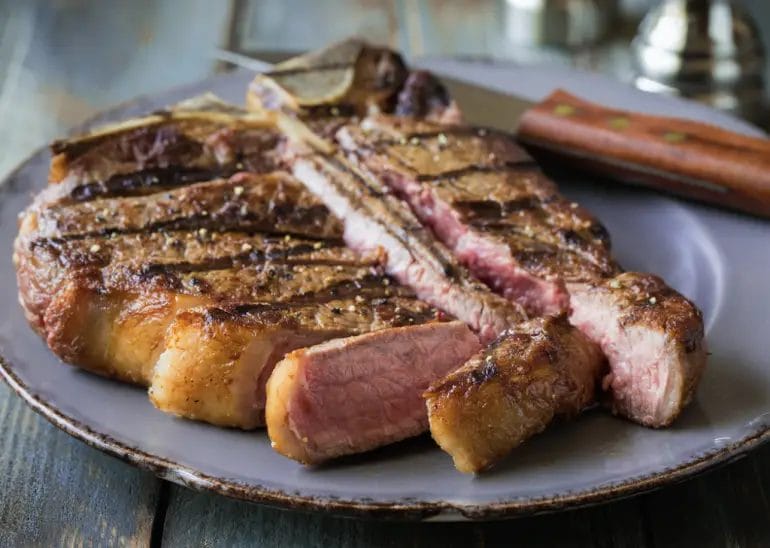
T-bone steak vs. other cuts of beef: a nutritional comparison
When it comes to choosing the perfect cut of beef, there are numerous options available. Among them, the T-bone steak stands out as a popular choice for many meat lovers.
But how does it compare to other cuts of beef in terms of nutrition? Let’s take a closer look at the nutritional profile of T-bone steak in comparison to other cuts.
T-bone steak
The T-bone steak is a prime cut of beef that comes from the middle portion of the short loin. It is named after the T-shaped bone that runs through the middle, separating the tenderloin on one side and the striploin on the other.
This unique combination of two different cuts adds to the flavor and tenderness of the T-bone steak.
In terms of nutrition, a 3-ounce (85 grams) serving of T-bone steak provides:
- Protein: T-bone steak is an excellent source of high-quality protein, with approximately 22 grams per serving. Protein is essential for building and repairing tissues, supporting immune function, and producing enzymes and hormones.
- Fat: T-bone steak is known for its marbling, which refers to the visible fat within the muscle fibers. This marbling enhances the flavor and juiciness of the steak. However, it also means that T-bone steak contains a relatively higher amount of fat compared to leaner cuts. A typical serving of T-bone steak contains around 17 grams of fat, with a mix of saturated and unsaturated fats.
- Iron: The T-bone steak is a good source of iron, providing approximately 15% of the recommended daily intake. Iron is crucial for the production of red blood cells and oxygen transportation in the body.
- Vitamins and minerals: T-bone steak contains various vitamins and minerals, including vitamin B12, zinc, selenium, and niacin.
Other cuts of beef
While the T-bone steak offers a delicious combination of tenderloin and striploin, other cuts of beef also have their nutritional merits. Here are some popular cuts and their nutritional highlights:
| Cut | Protein (per 3-ounce serving) | Fat (per 3-ounce serving) | Iron (per 3-ounce serving) |
|---|---|---|---|
| Ribeye steak | 23 grams | 19 grams | 12% of recommended daily intake |
| Sirloin steak | 23 grams | 11 grams | 11% of recommended daily intake |
| Filet mignon | 20 grams | 8 grams | 10% of recommended daily intake |
These cuts of beef also provide a good amount of protein, with similar levels to the T-bone steak. However, their fat content may vary. Ribeye steak tends to have a higher fat content due to greater marbling, while sirloin steak and filet mignon tend to be leaner.
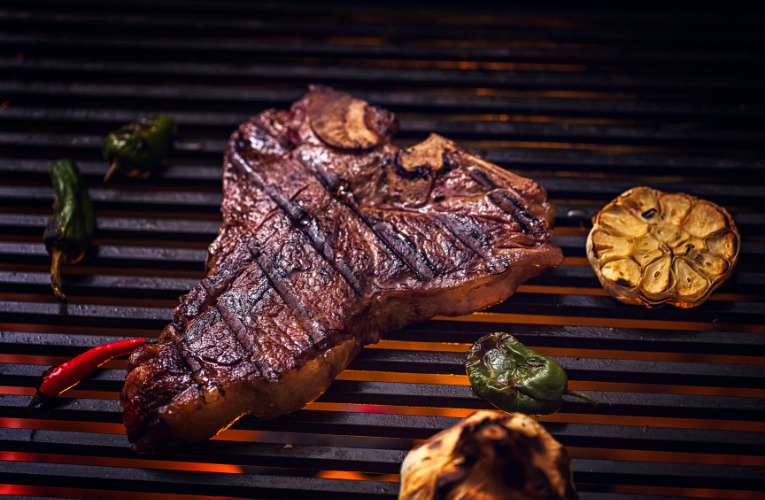
Incorporating T-Bone Steak into a Balanced Diet
T-bone steak is a delicious and flavorful cut of beef that can be a great addition to a balanced diet. While it is true that red meat should be consumed in moderation, T-bone steak can provide essential nutrients when incorporated into a well-rounded meal plan.
Here are some tips on how to incorporate T-bone steak into a balanced diet:
1. Choose lean cuts
When selecting a T-bone steak, opt for lean cuts to reduce the intake of saturated fat. Look for cuts that have less marbling and trim any excess fat before cooking. This will help to keep the overall fat content lower while still enjoying the rich flavor of the steak.
2. Balance with vegetables
Pair your T-bone steak with a variety of colorful vegetables to create a balanced meal. Vegetables provide essential vitamins, minerals, and fiber, which can help to offset the higher fat content of the steak.
Consider steaming or roasting vegetables like broccoli, carrots, or asparagus to complement the flavors of the steak.
3. Incorporate whole grains
Complete your meal by including whole grains such as brown rice, quinoa, or whole wheat bread. Whole grains are an excellent source of complex carbohydrates and provide sustained energy. They also add a satisfying texture to the meal and help to make it more filling.
4. Moderate portion sizes
When enjoying T-bone steak, it’s important to be mindful of portion sizes. Aim for a serving size of around 3-4 ounces, which is about the size of a deck of cards. This allows you to savor the flavors without overindulging. Remember, balance is key when it comes to incorporating any type of meat into your diet.
5. Choose healthy cooking methods
Opt for healthier cooking methods to prepare your T-bone steak. Grilling or broiling the steak helps to reduce the amount of added fat compared to frying or pan-searing. Avoid using excessive amounts of oil or butter when cooking to keep the overall fat content in check.
6. Include variety in your diet
While T-bone steak can be a tasty addition, it’s essential to have variety in your diet. Incorporate other protein sources such as poultry, fish, legumes, and tofu to ensure you’re getting a wide range of nutrients. This variety will help you maintain a balanced and nutritious diet.
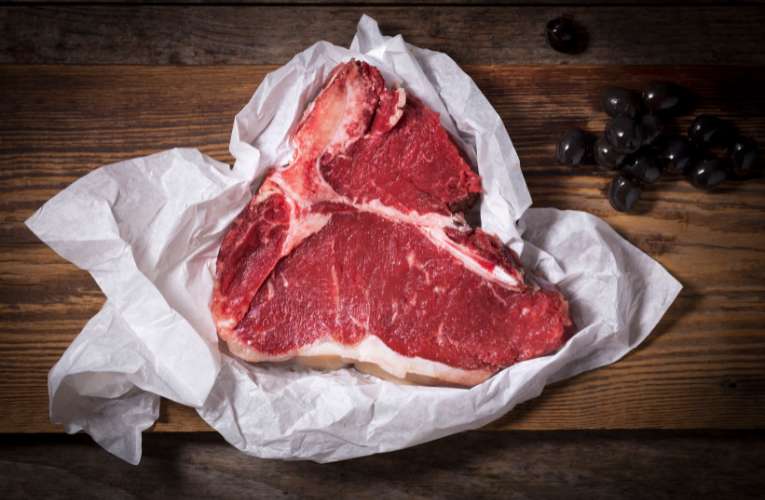
FAQs
Is T-bone steak healthy?
T-bone steak can be part of a healthy diet when consumed in moderation. It is a good source of protein and essential nutrients like iron, zinc, and B vitamins.
However, it is also high in saturated fat, so it’s important to balance it with other lean protein sources and incorporate plenty of fruits, vegetables, and whole grains in your meals.
Conclusion
The healthiness of T-bone steak depends on various factors. While T-bone steak is a rich source of protein, iron, and B-vitamins, its high saturated fat content may pose health risks if consumed in excess or by individuals with certain medical conditions.
However, when enjoyed in moderation as part of a balanced diet, T-bone steak can be a nutritious and delicious choice.
It is important to consider the quality and cooking method of the steak to minimize the intake of harmful substances such as heterocyclic amines (HCAs) and polycyclic aromatic hydrocarbons (PAHs).
A well-done or charred steak may contain higher levels of these compounds. Overall, incorporating T-bone steak into your diet in a mindful manner can provide you with valuable nutrients and a satisfying culinary experience.

